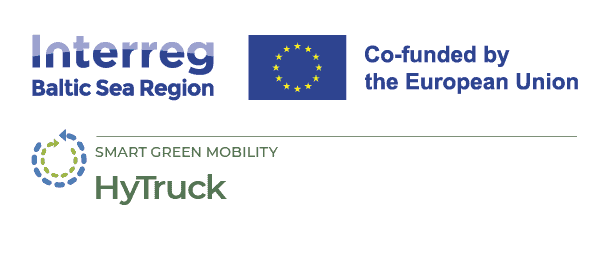
Hydrogen in Heavy Duty Transport - The Swedish Perspective
15 September 2024
The twelfth HyTruck Breakfast Briefing on 4th September 2024 was hosted and moderated by Hadi Farabi, Chalmers University of Technology. 60 people participated the meeting.
The first speakers were Monica Johansson and Lucien Koopmans from Volvo Group, a manufacturer of wide variety of vehicles and power solutions. Volvo is on a transition path towards net-zero mobility services by 2040 and is aiming to reduce CO2 emissions with multiple means. For example, in addition to low emission powertrain options, Volvo will produce world’s first fossil free steel vehicles. For powertrain option Volvo is developing battery electric vehicles (BEV), fuel cell electric vehicles (FCEV) and internal combustion engines (ICE) operated with renewable fuels, such as green hydrogen. As a comparison of different fuel alternatives, BEV and green H2 FCEV are the least CO2 intensive powertrain options.
For utilising hydrogen in mobility, Volvo is focusing on FCEV and hydrogen ICE solutions simultaneously. FCEV has higher cost than ICE, but it also has higher operational range due to the better efficiency and only exhausts water vapour. Hydrogen ICE vehicle has lower production cost, but a slightly lower efficiency and potential NOx emissions can be seen as a small disadvantage of the technology when compared to FCEV.
Volvo is already testing FCEVs in different operating environments and good performance figures have been achieved even in the harshest conditions. For pushing the technology through its limits, Volvo is already investigating NextGen fuel cells solutions.
Volvo is also developing mobile hydrogen refuelling solutions, which would ease the operation of hydrogen fuelled heavy machinery like construction machines.
As second speaker Pawel Seremak,Vätgas Sverige (Hydrogen Sweden) introduced the organiation as a leading platform for the Swedish hydrogen economy with more than 185 members, including industry, academia and public parties.
The global potential for hydrogen was 570 B$ already in 2023 with more than 1400 projects worldwide. However, the final investment decision rate is the highest in China (35%) and in USA (15%) while Europe reaches only 4%, indicating that the implementation of hydrogen projects and solutions need to be accelerated in EU.
In global level there are multiple policies boosting green H2 investments. In EU there are more than ten policies and initiatives which could speed up the implementation of hydrogen economy. Net Zero Industry Act is seen one of the most important tools to response USA’s IRA and to accelerate the scaling up of clean technologies in EU and support Fit For 55 initiative.
Swedish Energy Agency is coordinating the work with hydrogen in Sweden and is developing the role of hydrogen in the energy system. The result will be reported to Swedish government.
In Sweden, there are five HRS already in operation while AFIR requires minimum 33 stations. 20+ HRS cases are under rapid development and more than 60 stations have been planned. Redundancy of stations is seen to be vital for both operators and consumers. The ramp-up period will be financially challenging for the HRS operators due to potential lack of customers.





